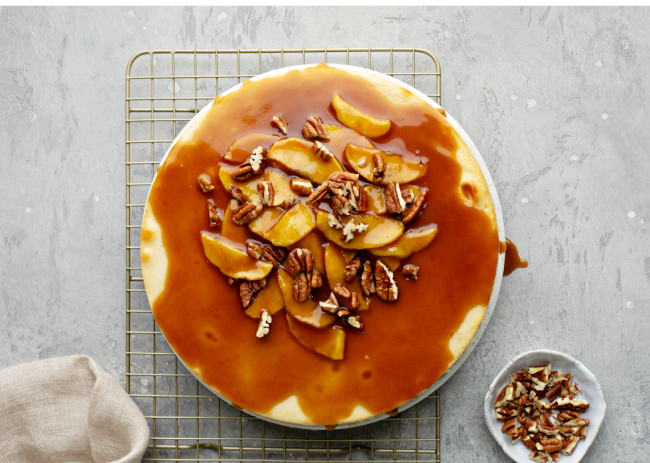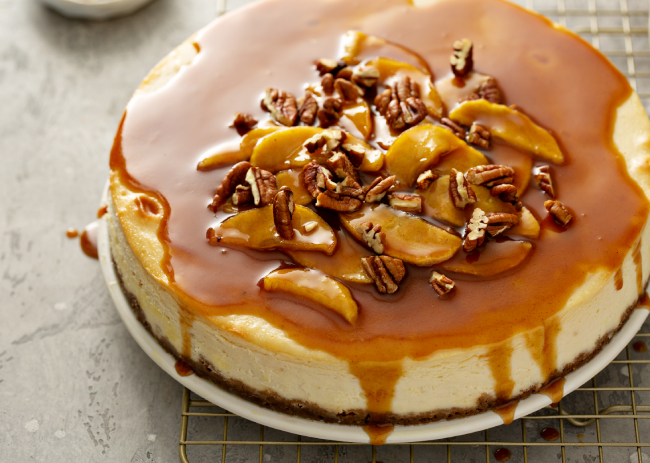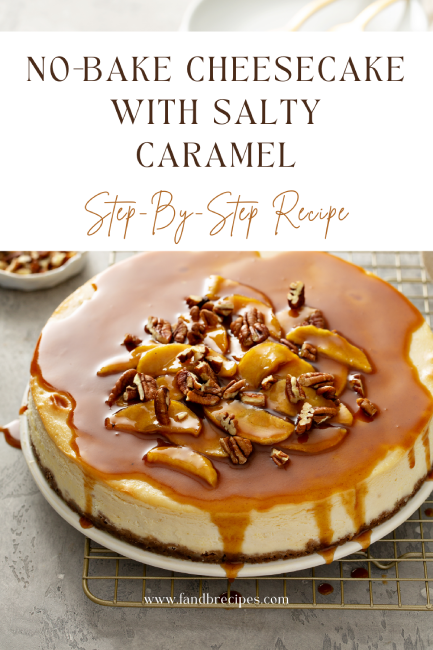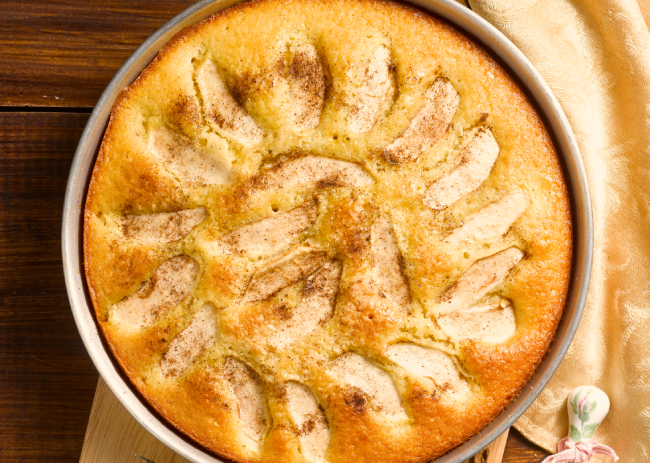No-Bake Cheesecake with Salty Caramel
The following salty caramel cheesecake includes a buttery biscuit base, a creamy no-bake filling that is flavour-infused with salted caramel, and a rich, opulent salted caramel sauce that is poured over the top.
It is simple to prepare, requires no baking, and is plainly adorned with a stunning golden sauce.
Cheesecake Origins: Greeks and Romans
We all got accustomed to eating cheese in savoury dishes, starting with appetizers that can include several kinds of cheese laid down on a cheeseboard to plates of pasta, and so on. But a cake that includes cheese… Any place in the western hemisphere of the globe will have its own recipe and manner of making this tasty speciality. These two foods combine to create a silky, luscious dessert that is enjoyed and anticipated by millions of people all over the world. One of the most amazing desserts ever created has to be cheesecake.
The Greek island of Samos is thought to have given rise to the first cheesecake-like forms. There, anthropologists found and excavated cheese moulds that were traced to roughly 2,000 B.C. At one point in time, cheesecake is rumoured to have served as the bridal dessert for Greek couples getting married. In contrast to the more complex recipes that are available now, a cake was produced using the particular ingredients of cheese, wheat, flour, and honey, and it was then baked. The first Greek cheesecake recipe, the earliest Greek dessert that has been recorded in writing and survived, is attributed to the author Athenaeus in the year 230 A.D.
The cheesecake recipe was one of the assets the Romans brought back from their successful invasion of Greece. They changed it by adding eggs and cheese crumbles to the mixture. A heated brick fireplace was used to cook these ingredients, and the resulting dish was served hot. Romans occasionally served cheese filling within a pastry as a dessert and called their cheesecake “Libuma”. The Roman cheesecake recipe, thought to be the first of its sort, is attributed to Marcus Cato, a Roman politician who flourished in the first century B.C.
Passed on to Europeans
As their empire expanded, the Romans gave the Europeans recipes for dishes like cheesecake. Eastern Europeans and Britons began experimenting with various methods to provide cheesecake with its characteristic flavour. As individuals started utilizing items that were local to each country in Europe, the recipes started to take on a new ethnic form. In the year 1545, the first cookbook was released. There was much discussion over the cheesecake being a flour-based confection made with sugar.
The cheesecake recipe was created in collaboration with Henry VIII’s chef. It appears that the King of England’s food preparer cut up some cheese into tiny pieces and then soaked them in milk for three hours. Then, after filtering the liquid, he added eggs, butter, and sugar.
However, cheesecake did not start to take on the recognizable shape we are accustomed to nowadays until the 18th century. Around this time, Europeans started using beaten eggs instead of yeast to raise their loaves of bread and cakes. This was a huge advancement in baking methods.
A cheesecake whose taste resembled candy rather than a savoury dish was produced as a result of the strong yeast flavour being concealed. Many immigrants who immigrated to the US from Europe brought cheesecake recipes with them.
Japanese Gave It a Final Touch
Japanese cheesecake is an oriental delicacy that has an unassuming appearance. It frequently takes the shape of a tall, one-layer cake that is dusted with powdered sugar. It makes sense why purchasing a decent Japanese cheesecake is so popular.
When cream cheese is added to the cake mix, a Japanese cheesecake is the result. It blends the qualities of a light and airy sponge cake with the texture of a rich custard. The end result is an incredibly moist sponge cake since traditional sponge cakes are frequently produced by immersing each layer in syrup in order to make them more moist. It also looks beautiful and is straightforward.
The egg whites must be whisked separately according to the customary manner. The cheesecakes acquire a fluffy and light structure as a result. As a result, the texture is different from a typical cheesecake in that it is much lighter and sponge-like. They still, however, possess that silky, delectably decadent texture.
One more important distinction: Although they can be eaten cold, customarily they are devoured hot, straight from the oven, allowing them to melt in your mouth right away.
Benefits of Eating Salty Caramel Cheesecake
You might believe that cheesecake is only a delectable and decadent guilt-free dessert. And while it is true that cheesecake may pack a calorie punch, to which caramel contributes for sure, this creamy dessert also has some unexpected health advantages. You could be completely unaware that cheesecake in general, especially the kind with caramel, is healthier than regular cake.
There is no doubt, this sweet treat has some health advantages that make it worthwhile to occasionally indulge in. Although many people would think it is difficult to consider the health advantages of cheesecake, this sweet treat truly has plenty of good stuff.
- Packed with protein: Due to the high protein content of this decadent dessert, you will feel full and satisfied for a longer period of time after eating it. Traditional cheesecake, even without salty caramel, has as much as eight grams of protein per slice. Additionally, it will provide you with a boost of energy that you are going to require to make it through the day. Protein has also been demonstrated to support both muscle building and weight loss.
- Good source of calcium: Because of having a combination of two elements in high amounts, cheese and caramel, salty caramel cheesecake is an excellent supplier of calcium, present in both cheese and caramel. For the growth and maintenance of strong teeth, bones, and connective tissue, calcium is crucial. It also aids in the voluntary movement of muscles and the coagulation of blood. A single serving of this cheesecake can supply more than 20% of the 1,000 mg of calcium per day that is advised for adults. Cheesecake’s healthy calcium content makes it simple to absorb other necessary elements like magnesium and iron.
- Supports bone health: The fact that salty caramel cheesecake includes phosphorus, a mineral that helps in the absorption of calcium, promotes bone health, and helps stave off diseases like osteoporosis (especially caramel in the cake), is another reason why it is healthier than regular cake. Additionally, it is rich in vitamin A, which supports the development and upkeep of bones. A delightful complement to a balanced diet that promotes bone health can be this dessert.
- Helps lower blood pressure: Potassium, a mineral found in cheesecake, can assist with lowering blood pressure by balancing the body’s sodium levels. About 11% of the daily required potassium intake can be found in a slice of classic cheesecake. Therefore, having cheesecake on a regular basis can lower your blood pressure.
- Promotes healthy skin: Small levels of vitamin A, which is necessary for healthy skin, are present in caramel. Vitamin A can aid in the promotion of cell development and repair as well as the reduction of wrinkles and fine lines.
Enjoy the other health advantages of this delectable salted caramel cheesecake while making it: strengthening hair, nails, joints, gut health, vitamin C intake, improving your mood, and heart condition.
Making of No-Bake Cheesecake with Salty Caramel
Let us introduce you to the ingredients for making this treat.
For the base:
- Digestive biscuits: 300 g. You might use another comparable biscuit, any store-brand biscuit you are accustomed to, in place of my preferred digestive biscuit (Graham Crackers, which can be bought everywhere in large supermarkets or ordered online).
- Butter or baking spread: 135 g (melted). For the base of the biscuit, you can choose between butter and baking spread. Baking spread, in my experience, makes the cheesecake smoother to take out from the tin since it prevents the base from setting as firmly.
For the filling:
- Full-fat cream cheese: 750 g. Philadelphia cream cheese is the highest quality and thickest cream cheese, in my experience, to use for no-bake cheesecakes. Given they have not paid me to advertise them, I can freely tell you that I have used store-brand cream cheeses in a lot of my cheesecake recipes, and they have always turned out wonderful. However, if you can afford it, I believe Philadelphia is worth a little extra money.
- Icing sugar: 125 g.
- Salted caramel sauce: 150 g (homemade or good quality shop-bought); Find a recipe for a homemade caramel sauce on the Internet if you do not want to use store-bought.
- Double cream: 300 ml. It is crucial to use double cream, which has a 48% fat level, and full-fat cream cheese, as both of these components are necessary to make sure the no-bake cheesecake sets. Small dessert cups or ramekins are recommended if you wish to prepare a low-fat version because larger containers will not set properly enough to cut.
Decoration:
- Salted caramel sauce: 250 g; Read what I wrote for the salted caramel sauce for the filling.
Needed Tools
You really will not need any special equipment to make this cheesecake; you certainly already have all that is necessary in your kitchen. Online resources abound with solutions to typical queries about no-bake cheesecake. I strongly advise going through such instructions if you have never cooked a no-bake cheesecake before.
I also strongly suggest using digital kitchen scales to weigh your ingredients. It will produce the best outcomes and is the most exact method of measuring substances.
- Weighing scale to measure ingredients.
- 9-inch springform cake tin to make the cheesecake.
- Food processor for blitzing the biscuits.
- Tablespoon for mixing and spreading components.
- Bowl to whip up texture.
- Microwave for melting the caramel.
- Palette knife to smooth the edges after decorating.
The technique of cooking a no-bake salted caramel cheesecake is easy even for beginners and, after making it, it is all about time and patience for the cake to cool down in the fridge.
No-Bake Cheesecake with Salty Caramel Recipe
By now, you realize that the combination of salted caramel and the creamy luscious cream cheese filling is absolute heaven for your palate. Let us break down the preparation procedure. Prep time is estimated at 40 minutes and gives 12 servings.
- The biscuits are processed into crumbs in a food processor to create the biscuit base. Alternatively, gently wrap the biscuits in a dish or sandwich bag. Add baking spread or melted butter, stir, and then compact and level the batter into the baking pan. Place in the refrigerator to chill.
- Combine the cream cheese, icing sugar, and caramel sauce to make the filling by using an electric hand whisk or a food mixer with a whisk attachment. Double cream should be incorporated after the batter is quite thick and keeps its shape.
- Over the biscuit base, pour the filling into the tin and level it evenly. Set in the refrigerator for at least four hours or overnight. This means that it is best to eat it after eating dinner if you make the cheesecake during the day. It is actually quite all right because you can opt for, say, a healthy 30-minute cooked meal or order a pre-made healthy meal from one of the top-rated and certified meal delivery services to get a break from working in the kitchen and make “room” in your stomach for a slice of cheesecake later.
- Throw the salted caramel sauce in a bowl and heat it in the microwave for 15 seconds, or until it can be poured, then pour it over the cheesecake to serve and decorate. If it does not spread or drip sufficiently, use a palette knife to smooth it out and push it to the edges.
- Serve right away, put any leftovers in the refrigerator, and consume within two to three days.
Nutritional Info
- Calories: 527 kcal.
- Carbohydrates: 33 g.
- Protein: 6 g.
- Fat: 42 g.
- Saturated fat: 24 g.
- Trans fat: 1 g.
- Cholesterol: 127 mg.
- Sodium: 410 mg.
- Potassium: 142 mg.
- Fiber: 1 g.
- Sugar: 20 g.
- Vitamin A: 1489 IU.
- Vitamin C: 1 mg.
- Calcium: 86mg.
- Iron: 1 mg.
How to Store and Freeze This Cheesecake
The cheesecake should be kept for three to four days in the refrigerator. The non-decorated cheesecake can be frozen, but it must first cool in the refrigerator. It will not be as tasty if you freeze it because the texture will change.
You may take the cheesecake out of the tin and store it in a box or tupperware when it has chilled and set. You could also cut it into pieces and freeze them separately. When you are ready for cheesecake, you can then quickly defrost a few pieces at a time.
FAQs
Can I Substitute Mascarpone for Cream Cheese?
It is possible to use full-fat mascarpone cheese instead of full-fat cream cheese. Since cream cheese has a slight “tang” that you would expect from a cheesecake, I prefer to use it. Mascarpone is significantly creamier; a little too creamy in my opinion. However, you can use it in its place without a problem if you choose.
Can I Make This Cheesecake Gluten Free?
Yes! Replace the biscuit base’s biscuits with gluten-free biscuits to make this recipe gluten-free. Additionally, I advise you to examine the packaging of each ingredient in the recipe to rule out any potential cross-contamination; particularly, if you are giving this to someone who has a food allergy or intolerance.
How Do I Know That the Cheesecake Is Set?
The filling should be mixed to the point where you can scoop some with a spatula or spoon and have to tap the mixture against the side of the bowl or flick it with your wrist to get it off the spoon. You need to stir it more if it’s gloppy and slides off the spoon easily without any prodding. For optimal results, always use an electric mixer.
Additionally, it is crucial to use double cream (heavy cream) and full-fat cream cheese because using low-fat alternatives will change how the cheesecake is set. I always recommend putting cheesecake in the refrigerator overnight. Four hours is a minimum in my opinion.

No-Bake Cheesecake with Salty Caramel
Ingredients
For the base:
- 300 g Digestive biscuits
- 135 g Butter or baking spread melted
For the filling:
- 750 g Full-fat cream cheese
- 125 g Icing sugar
- 150 g Salted caramel sauce
- 300 ml Double cream
Decoration:
- 250 g Salted caramel sauce
Instructions
- The biscuits are processed into crumbs in a food processor to create the biscuit base. Alternatively, gently wrap the biscuits in a dish or sandwich bag. Add baking spread or melted butter, stir, and then compact and level the batter into the baking pan. Place in the refrigerator to chill.
- Combine the cream cheese, icing sugar, and caramel sauce to make the filling by using an electric hand whisk or a food mixer with a whisk attachment. Double cream should be incorporated after the batter is quite thick and keeps its shape.
- Over the biscuit base, pour the filling into the tin and level it evenly. Set in the refrigerator for at least four hours or overnight.
- Throw the salted caramel sauce in a bowl and heat it in the microwave for 15 seconds, or until it can be poured, then pour it over the cheesecake to serve and decorate. If it does not spread or drip sufficiently, use a palette knife to smooth it out and push it to the edges.
- Serve right away, put any leftovers in the refrigerator, and consume within two to three days.
- Note: You can add toppings of your choice such as pecans and apples.
Notes
Shristi is an avid reader, recipe developer and wellness enthusiast. She’s probably making a mess in her kitchen right now.





Amazing!! So good in taste
I love cheesecakes and this is so tasty and so easy to make! Thanks.